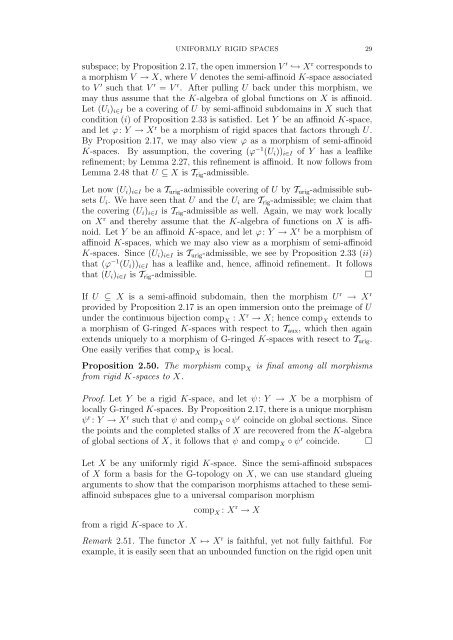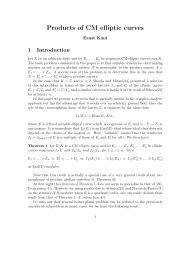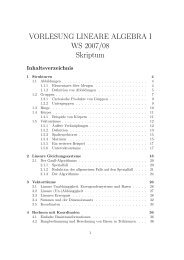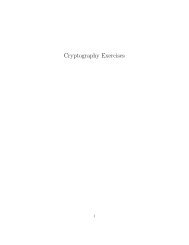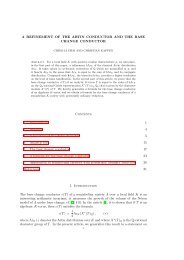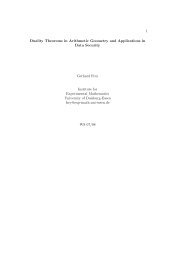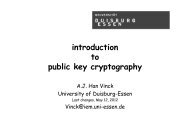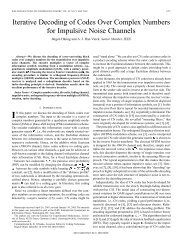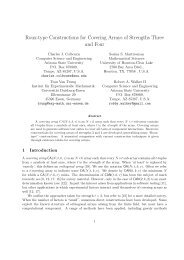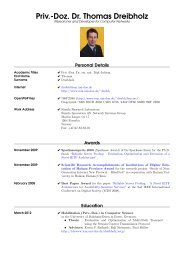UNIFORMLY RIGID SPACES 1. Introduction Let K be a non ...
UNIFORMLY RIGID SPACES 1. Introduction Let K be a non ...
UNIFORMLY RIGID SPACES 1. Introduction Let K be a non ...
Create successful ePaper yourself
Turn your PDF publications into a flip-book with our unique Google optimized e-Paper software.
<strong>UNIFORMLY</strong> <strong>RIGID</strong> <strong>SPACES</strong> 29subspace; by Proposition 2.17, the open immersion V ′ ↩→ X r corresponds toa morphism V → X, where V denotes the semi-affinoid K-space associatedto V ′ such that V ′ = V r . After pulling U back under this morphism, wemay thus assume that the K-algebra of global functions on X is affinoid.<strong>Let</strong> (U i ) i∈I <strong>be</strong> a covering of U by semi-affinoid subdomains in X such thatcondition (i) of Proposition 2.33 is satisfied. <strong>Let</strong> Y <strong>be</strong> an affinoid K-space,and let ϕ: Y → X r <strong>be</strong> a morphism of rigid spaces that factors through U.By Proposition 2.17, we may also view ϕ as a morphism of semi-affinoidK-spaces. By assumption, the covering (ϕ −1 (U i )) i∈I of Y has a leaflikerefinement; by Lemma 2.27, this refinement is affinoid. It now follows fromLemma 2.48 that U ⊆ X is T rig -admissible.<strong>Let</strong> now (U i ) i∈I <strong>be</strong> a T urig -admissible covering of U by T urig -admissible subsetsU i . We have seen that U and the U i are T rig -admissible; we claim thatthe covering (U i ) i∈I is T rig -admissible as well. Again, we may work locallyon X r and thereby assume that the K-algebra of functions on X is affinoid.<strong>Let</strong> Y <strong>be</strong> an affinoid K-space, and let ϕ: Y → X r <strong>be</strong> a morphism ofaffinoid K-spaces, which we may also view as a morphism of semi-affinoidK-spaces. Since (U i ) i∈I is T urig -admissible, we see by Proposition 2.33 (ii)that (ϕ −1 (U i )) i∈I has a leaflike and, hence, affinoid refinement. It followsthat (U i ) i∈I is T rig -admissible.□If U ⊆ X is a semi-affinoid subdomain, then the morphism U r → X rprovided by Proposition 2.17 is an open immersion onto the preimage of Uunder the continuous bijection comp X : X r → X; hence comp X extends toa morphism of G-ringed K-spaces with respect to T aux , which then againextends uniquely to a morphism of G-ringed K-spaces with resect to T urig .One easily verifies that comp X is local.Proposition 2.50. The morphism comp X is final among all morphismsfrom rigid K-spaces to X.Proof. <strong>Let</strong> Y <strong>be</strong> a rigid K-space, and let ψ : Y → X <strong>be</strong> a morphism oflocally G-ringed K-spaces. By Proposition 2.17, there is a unique morphismψ r : Y → X r such that ψ and comp X ◦ ψ r coincide on global sections. Sincethe points and the completed stalks of X are recovered from the K-algebraof global sections of X, it follows that ψ and comp X ◦ ψ r coincide. □<strong>Let</strong> X <strong>be</strong> any uniformly rigid K-space. Since the semi-affinoid subspacesof X form a basis for the G-topology on X, we can use standard glueingarguments to show that the comparison morphisms attached to these semiaffinoidsubspaces glue to a universal comparison morphismfrom a rigid K-space to X.comp X : X r → XRemark 2.5<strong>1.</strong> The functor X ↦→ X r is faithful, yet not fully faithful. Forexample, it is easily seen that an unbounded function on the rigid open unit


